by Daniel Hathaway
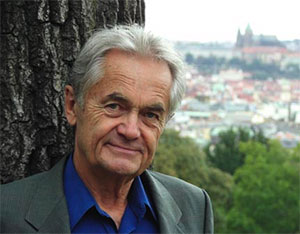
In December of 2008, shortly after the launch of ClevelandClassical.com, we interviewed Karel Paukert about his forthcoming January performance of the Messiaen work at St. Paul’s Episcopal Church in Cleveland Heights. That performance observed the centenary of the famous French composer’s birth. Paukert’s reflections on La Nativité and on his own career, reprinted below, remain highly relevant six years later.
• • •
Born in Prague, Karel Paukert came to the US by way of Reykjavík and Belgium. He taught and played organ in St. Louis and Evanston, IL before becoming a US citizen in 1972 and curator of musical arts at the Cleveland Museum of Art in 1974. During his thirty years in that post he played more than 800 organ recitals, administered two highly respected concert series, founded the Aki Festival of new music and arranged for the personal appearance of Olivier Messiaen and Yvonne Loriod in Cleveland in 1978.
Paukert has kept busy since CMA. “I go twice a year to teach at the Academy of Performing Arts in Prague, I play overseas recitals, and I just recorded a new CD with Jaroslav Tuma at a pilgrimage church close to Prague including improvisations we did just for fun, pairing organ with harpsichord — one on the Pink Panther tune, and another as an homage to Ligeti.”
Paukert enjoys working with organ students in Prague, but acknowledges the limited job opportunities they have in their field. “The Czech Republic has a lot of dedicated people, but church positions don’t pay. You have to have other interests and enterprises, like technical jobs in broadcasting.” Paukert was a bit shocked to discover how much support the Czech government still gives to radio and television. “One TV station asked last August to interview me about a forthcoming program, but I said I didn’t have a car and wasn’t sure how to get there. So they said, ‘we’ll send a driver.’ He drove me to a complete palace — just like under the communists — with big hallways, and hundreds of employees.”
Paukert sees other significant changes in the Czech Republic, however. “The difference between generations is huge. While we had to learn Russian, they speak English and German and go to France to study and are showered with scholarships. This is all new and on par with the rest of civilized Europe. The organs are getting better, too.”
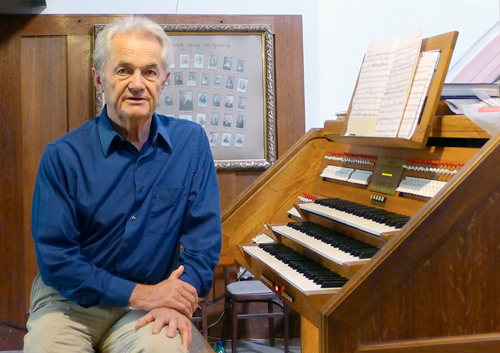
Paukert at the Church of the Assumption in Chrudim, Czech Republic, July, 2011
Paukert’s Czech heritage was a godsend to The Cleveland Orchestra in the spring of 2008 and afforded him a personal thrill. “In preparing the soloists and chorus for Dvořák’s Rusalka, they had hired a diction coach, but something happened, so I worked with the stars and the singers to get all the Czech inflections correct. They were so appreciative — and it was the highlight of my year.”
Since leaving the Museum, Paukert has also been able to devote more attention to his post as organist and choirmaster at St. Paul’s, “the kind of job I should have been doing all these years but I didn’t have the time.” Because he has continuously served churches during his career — the cathedral in Ghent; a Unitarian congregation and a Catholic preparatory seminary in St. Louis; St. Luke’s Episcopal Church in Evanston; and now St. Paul’s — we asked about his enthusiasm for working as a church musician. “I just feel that the place for an organist is in the church. Some can exist just by concertizing, but I love interacting with people. I love the hymns and the congregational singing.”
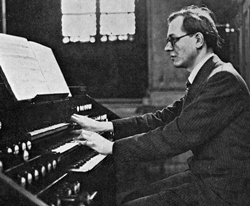
Messiaen at La Trinité, 1940
This is an area in which Paukert clearly identifies with Olivier Messiaen, who was titular organist of La Trinité in Paris for decades — and Paukert missed that aspect of his life during his first few years in Cleveland. “At the art museum, I felt lonely. I’d play a recital and have no feedback afterwards.” And he was constrained from taking a church position because then director Sherman Lee wanted him to spend 100% of his time and energy on the museum’s programs.
The breakthrough came in 1979. “I used to swim at the Y a couple of mornings a week at the same time as Charlie Carr, the organist of St. Paul’s. We were in the showers at 7:15 one day when Charlie turned to me and asked through the steam if I would be interested in his job at St. Paul’s because he wanted to go back to graduate school.”
When Paukert was formally approached by the church, he went back to Lee to beg for a trial period, and this time the director felt he couldn’t refuse because his wife was a member of the congregation at St. Paul’s. Ironically, on the same day, he was contacted by the pastor of the Church of the Covenant about the job that was open there.
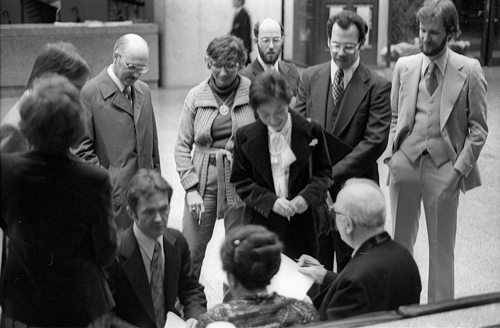
The Messiaens & Karel Paukert at CMA 1978.
Top right: organists Charles Ruggles, Bruce Shewitz
and Timothy Robson (who writes for ClevelandClassical.com).
Paukert’s direct involvement with Olivier Messiaen dates back to his arrival at CMA in 1974 when his friend, the German organist Almuth Rößler, promised that she would engineer a Cleveland visit by the composer for his 70th birthday four years later. The engagement turned into a weeklong residency for Messiaen and Loriod in Cleveland, and Paukert has fond memories of their visit. (Read Timothy Robson’s recollections here.)
“I was fortunate to spend the week with Messiaen and bussed him around everywhere. He wanted to go to the museum every day to venerate the Indian goddesses (his wife was amused by this). He was orchestrating St-François d’Assise at the time. His French was much too florid to understand and he talked constantly about the end of time, whispering to himself. What I could grasp was the nobility of his music paralleled in his speech. His non-material music swims somewhere between earth and heaven.”
In returning to La Nativité now and again, something Paukert does at least annually, he’s struck both by its longevity and by its appeal to listeners. “By now it’s a classic and I come back to it as music that is really part of our genetic makeup. Perhaps this is not so much true of his later pieces (like Livre d’Orgue) which are puzzles, difficult to listen to, and difficult to play. Like Vision of the Eternal Church and Le Banquet Céleste [the two other works Paukert played on his program in 2008], the Nativity is readily accepted.”
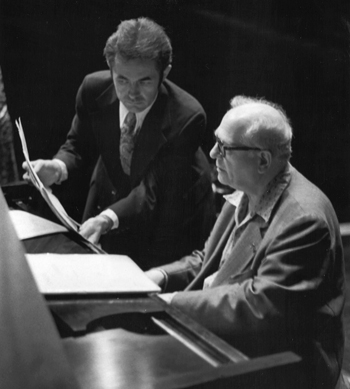
Paukert and Messiaen in Cleveland, 1978.
Paukert recently performed Messiaen’s Monodie (a piece whose starkly unison movements resemble parts of the Quartet for the End of Time and Le Corps Glorieux), and found that audiences had a difficult time understanding why one would play just a single line. “On the other hand, La Nativité appeals to the poetically inclined. It’s not just Christian — there are so many connecting points — it stands on its own musical ground.”
As an additional dimension, Paukert said that the composer brings all the religious aspects of faith together. “He says, ‘I am Messiaen all the time; I’m Roman Catholic next.’”
Karel Paukert agrees with other performers who find Messiaen’s musical logic more and more compelling as the years go by. “Originally, his slow tempi eluded me, but then I began to understand him more, and it began to make sense. My performance will be somehow more expansive.” And longer. “On his recordings, Messiaen plays the work in 62 minutes,” Paukert said. “My average used to be 50 and sometimes as little as 47, so I will try to calm myself down. I can’t accept something I can’t believe, but I’m really enjoying entering Messiaen’s mystical zone, which is very slow and exalted.”
Paukert finds that playing Messiaen in churches makes sense out of some aspects of the music that don’t quite work in concert halls — like the lengthy pauses which take long reverberation times into consideration. “I’ve always wanted to shorten Messiaen’s rests, which are often so long when you observe them literally that it seems like you’re starting a new piece. But in church, being able to look at things like the cross and the pulpit just seems to fill the rests. You’re supposed to take the time to admire the stained glass windows, then everything makes sense.”
The neoclassical 1952 Holtkamp organ in St. Paul’s [like the organ in Gartner Auditorium, rebuilt by Holtkamp in 1971] is a long way tonally from the super-romantic 1869 Cavaille-Cöll in La Trinité. “Messiaen’s instrument seems minimalist in that space, somehow very much in the distance and more mystical. St. Paul’s is more in your face.” But Messiaen was extremely flexible and generous about how his music got played and what registrations or stop selections were used. “Almuth Rößler told me that she was surprised that Messiaen happily reworked all his registrations for the Johanniskirche in Düsseldorf” (also a neoclassical organ, built by Rudolf von Beckerath in 1954). “Messiaen said to her, ‘the directions are for students, but you are an artist and can do it your way.’”
Published on ClevelandClassical.com January 20, 2015.
Click here for a printable copy of this article



